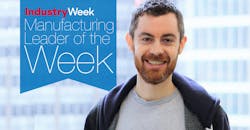Machinio Just Might be Saving Companies Says CEO
Machinio is in business today because co-founder Dan Pinto couldn’t find what he was looking for.
While that might sound existential, in fact, it’s quite practical as he was looking for a used printing press. The process was so difficult that he did what any Millennial would do; he built technology to crawl the web, aggregate listings and find what he needed.
The next step was to enlist his childhood friend, and business partner, Dmitriy Rokhfeld and in 2013 they launched the company, which has its headquarters in Chicago.
IndustryWeek talked to Rokhfeld about his business, leadership style and future.
IW: Matching buyers and sellers online doesn’t sound like a “disruptor” to business, yet that is what you are doing.
Rokhfeld: The concept is simple and been done in other verticals such as travel (Kayak) and human resources ( Indeed) so it was surprising to us that nothing like that existed for used machinery. Matching buyers and sellers in this market doesn’t have the cachet that other tech startups have. But for us it was perfect as we had knowledge of the industry as well as the technological base.
As the used machinery business is mostly comprised of small business owners, many didn’t have the time or technology to create broad-based online tools to facilitate this trade beyond their current network.
When we approached dealers with the proposition that we could make the selling process seamless by creating a duplicate of their site on our site that updates in real-time, a huge pain point, they were happy to jump on board.
Currently, over 550,000 interested machinery buyers from 190 countries visit Machinio.com each month looking for used machines and heavy equipment.
Another pain point for dealers was vetting buyers. In our system as soon a buyer submits a lead, we go into action and thoroughly research the lead before we pass it on to the dealer. Every month we disqualify 15,000 leads, 25% of all leads generated. This vetting process impressed one of the largest John Deere dealerships, Sloan Implement (founded in 1931), who found that the market had a lot of scammers. They became customers of Machinio.
IW: What is the mission of your company?
Rokhfeld: We feel that our technology is offering businesses, many of which are small and multi-generational, a way to remain competitive. With the rise of the Internet, buyers have more choices than ever. Whereas in the past they might have gone back to the same dealer they have worked with for years, now many will at least explore what else is out there. For a dealer to continue growing their business into the future, they will need to reach those buyers who no longer come to them directly and of course new buyers.
As 1,600 business owners are using our site and we feel we are an active part in helping many small, or Mom and Pop, types of businesses stay afloat and be able to pass the business down to the next generation.
IW: How did you choose which sectors to include?
Rokhfeld: From day one we focused on a number of markets. While that’s not what most startups do, we were fortunate as different markets have grown at different rates. We serve the agriculture, construction, machine tools, printing, process and trucking industries.
Some of the industries have been slower to adapt to this technology and others had been searching for this type of solution. Early on Ritchie Bros., the largest industrial auctioneer of used equipment in the world, invested in us and they helped us gain the trust of dealers.
We also started with a global marketplace. Currently, 50% of our revenue comes from outside of North America.
Q: What is your leadership style?
A: Rokhfeld: We have a very clear focus. We are not trying to solve many problems at once, although there are many inefficiencies that technology can solve. Our singular mission is to connect dealers with buyers. The entire company is behind this one simple goal. Every decision is made with this in mind; addressing this pain point.
We also have a handful of KPIs that we use. One of our early investors, Indeed.com, helped us clarify our KPIs. We didn’t get distracted by the “shiny objects” that technology can produce. Every decision has to impact those KPIs. This clarity also helped us work on other ideas that we have in our product roadmap.
Our workforce is almost entirely comprised of millennials. And this group wants to feel passionate about their jobs. Our workforce feels strongly that they are providing a value and this has been reflected by our very low turnover.
IW: What does the future look like for your company?
Rokhfeld: This year we opened an office in Berlin when we realized how much business was coming from that location. We plan to take a similar approach with the Asian market. When we feel there is enough business to justify opening an office there we will.
We also plan to expand our services if we can provide value. For example, we do provide inside reports or inventory to help companies better manage their business. As we feel that we are able to provide additional services to the dealers we will step into those areas.
Personally, I feel that we are at the tip of an iceberg when it comes to future opportunities.
